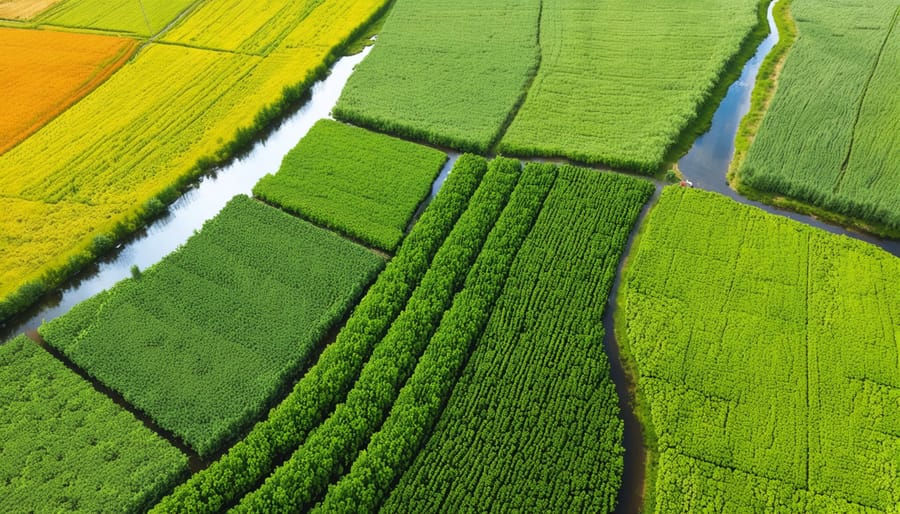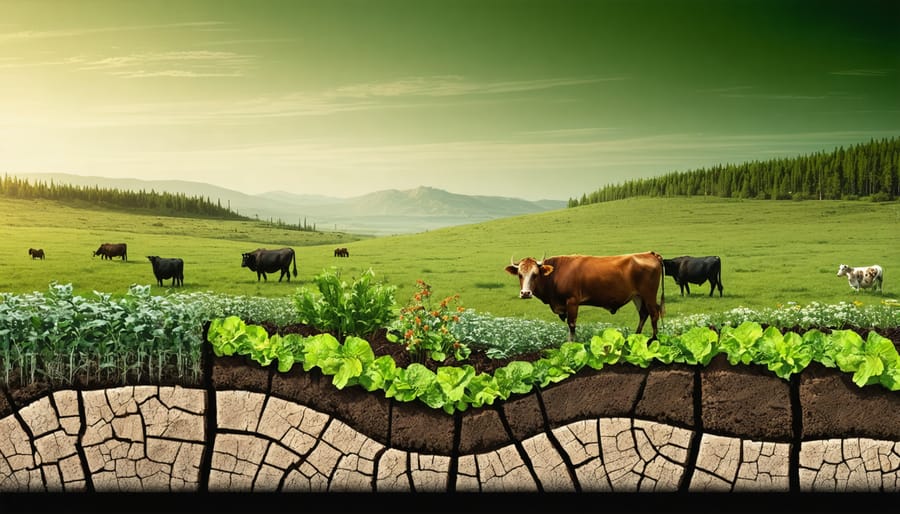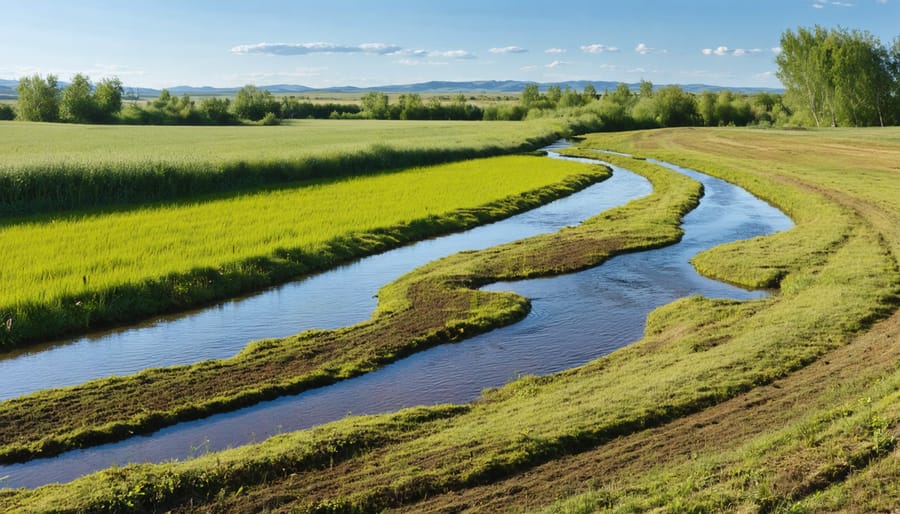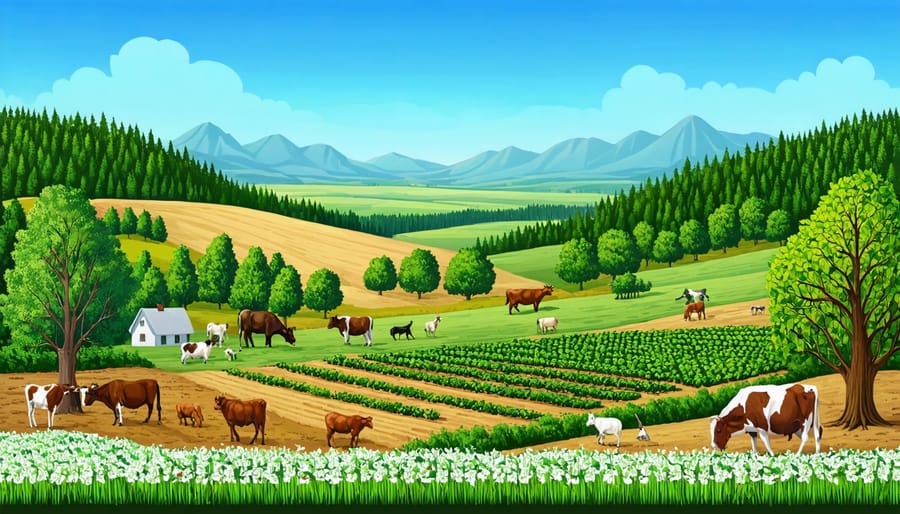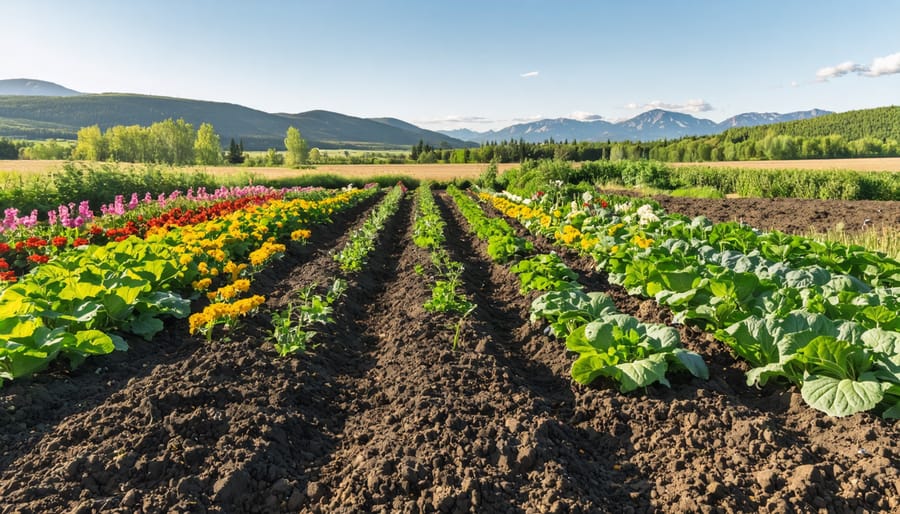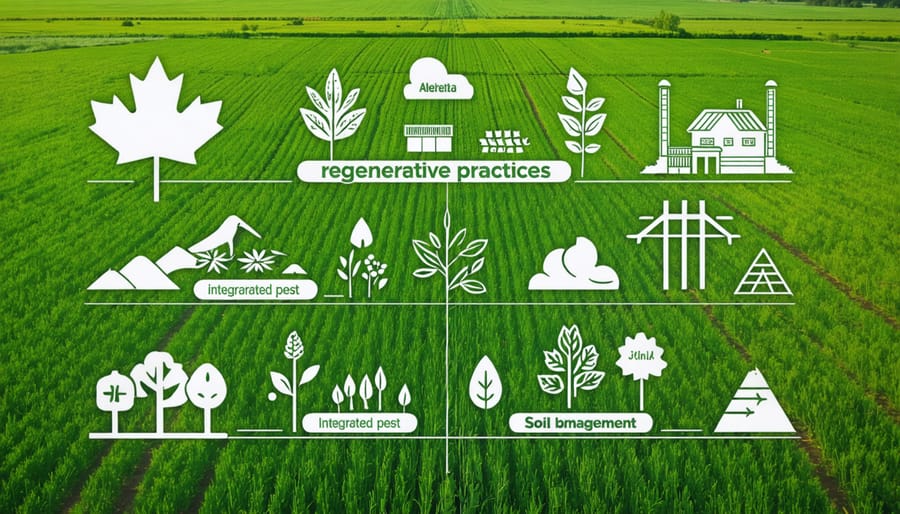Transform your farm’s organic waste into nutrient-rich soil by mastering plant-based composting, a cornerstone of regenerative agriculture that’s revolutionizing Canadian farming practices. From Prairie wheat stubble to orchard prunings, plant materials provide the perfect foundation for building living soil that retains moisture, suppresses weeds, and strengthens crop resilience against Alberta’s challenging climate extremes.
Local success stories, like the Morrison Family Farm in Red Deer County, demonstrate how switching to plant-based compost systems has cut fertilizer costs by 40% while boosting soil organic matter from 2% to 5% in just three growing seasons. This sustainable approach aligns perfectly with Canada’s climate-smart agriculture initiatives, offering farmers a practical path to improved soil health and increased crop yields.
Beyond the environmental benefits, plant-based composting creates a closed-loop system that turns agricultural “waste” into black gold. Recent University of Alberta research confirms that properly managed plant-based compost delivers a balanced nutrient profile that outperforms synthetic fertilizers in long-term soil building and crop productivity, while significantly reducing operational costs for Canadian farmers.
Step into the future of regenerative farming – your journey to soil transformation starts with the plant materials already available on your land.
What Makes Plant-Based Compost Different?

Nutrient Profile Analysis
Plant-based compost delivers a rich spectrum of essential nutrients that significantly enhance your soil’s organic matter content. The primary macronutrients found in quality plant-based compost include nitrogen (N), phosphorus (P), and potassium (K), typically in ratios of 1.5-3.5% N, 0.5-1.5% P, and 1-2% K.
What sets plant-based compost apart is its balanced delivery of secondary nutrients like calcium, magnesium, and sulfur, along with vital micronutrients including zinc, manganese, and iron. These elements work together to support robust nutrient cycling and strengthen soil structure.
For Alberta’s predominantly Prairie and Parkland soils, plant-based compost is particularly beneficial as it helps retain moisture and provides slow-release nutrients throughout our shorter growing season. The stable organic matter in plant-based compost also helps buffer soil pH, making nutrients more available to crops while supporting beneficial soil microorganisms essential for long-term soil health.
Carbon-to-Nitrogen Ratios
In Alberta’s unique soil conditions, maintaining the right carbon-to-nitrogen (C:N) ratio is crucial for successful plant-based composting. The ideal ratio typically falls between 25:1 and 30:1, which allows for optimal decomposition while considering our shorter growing season and colder climate.
For best results in our prairie conditions, combine brown materials (high in carbon) with green materials (high in nitrogen) in the right proportions. Common carbon-rich materials include straw from wheat or barley (40:1 ratio), dried leaves (60:1), and wood chips (100:1). Nitrogen-rich materials include fresh grass clippings (15:1), vegetable scraps (12:1), and legume plants (10:1).
Local farmers have found success by adjusting these ratios seasonally. During spring and fall, when temperatures fluctuate significantly, increasing carbon materials by 10% helps maintain consistent decomposition rates. In summer, standard ratios work well, but moisture monitoring becomes essential due to our typically dry conditions.
Remember that these ratios aren’t exact science – aim for roughly three parts carbon materials to one part nitrogen materials by volume. This approach has proven effective across various Alberta growing zones, from Medicine Hat to Grande Prairie.
Creating Effective Plant-Based Compost
Material Selection
In Alberta’s diverse agricultural landscape, selecting the right plant materials for composting is crucial for success. Start with readily available materials like crop residues from wheat, barley, and canola, which are abundant after harvest. These materials provide excellent carbon content and structure to your compost pile.
Local tree leaves, particularly from poplar and aspen, make excellent additions during fall. Garden waste, including spent vegetables and annual flowers, contributes valuable nitrogen and diverse nutrients. Remember to include green materials like lawn clippings and fresh weeds (before they go to seed) to maintain proper carbon-to-nitrogen ratios.
For optimal results, combine materials from different sources. Mix woody prunings from shelterbelts with softer materials like alfalfa or clover to create balanced compost. Many Alberta farmers have success incorporating cattails and wetland plants, which are naturally rich in minerals.
Avoid materials treated with pesticides or herbicides, as these can inhibit decomposition and affect compost quality. Similarly, exclude diseased plants to prevent spreading pathogens. In our prairie climate, collecting and storing dry materials during summer months ensures a steady supply for year-round composting.
Consider partnering with neighbouring farms or local greenhouses to exchange complementary materials. This community approach not only diversifies your compost ingredients but also strengthens local agricultural networks.

Seasonal Considerations
In Canada’s diverse climate zones, successful plant-based composting requires strategic adaptation throughout the year. During the warm season (May to September), composting activities naturally accelerate, with optimal temperatures between 15-25°C promoting robust microbial activity. This is your prime time for collecting fresh green materials like lawn clippings, garden waste, and crop residues.
Winter composting presents unique challenges but remains feasible with proper planning. When temperatures drop below freezing, microbial activity slows significantly, but doesn’t stop completely. Create larger piles (minimum 1 cubic metre) to maintain core heat, and insulate with straw or snow banks. Continue collecting kitchen scraps and storing them in covered containers until spring, when they can be incorporated into your system.
For Alberta farmers, spring and fall require special attention. In spring, gradually uncover winter piles and add nitrogen-rich materials like early green growth to reactivate decomposition. Fall preparation is crucial – stockpile dry brown materials like leaves and straw, which become scarce during winter months. Consider building a three-bin system under cover to maintain year-round composting capability.
Moisture management varies seasonally. During hot prairie summers, maintain 50-60% moisture content by regular watering and covering piles to prevent excessive drying. In wet seasons, ensure adequate drainage and use more brown materials to absorb excess moisture. A simple squeeze test should yield a few drops of water – adjust your mix accordingly.
Many Alberta farmers successfully adapt their composting schedule to local conditions. For example, the Thompson family farm near Red Deer maintains active compost production year-round by using greenhouse waste in winter and integrating snow management into their composting strategy. They’ve found that positioning their compost site on the south-facing side of a windbreak optimizes solar gain during colder months while protecting materials from desiccating winter winds.
Alberta Success Stories
Throughout Alberta, farmers are demonstrating remarkable success with plant-based composting systems, proving that this sustainable approach works effectively in our unique climate. Let’s explore some inspiring local success stories that showcase the practical benefits of this method.
Sarah and Tom Henderson of Sundre Valley Farm transformed their 160-hectare operation by implementing a comprehensive plant-based composting system five years ago. “We started small, using crop residues and fallen leaves,” Sarah explains. “Today, we produce about 200 tonnes of compost annually, saving us roughly $15,000 in synthetic fertilizer costs.” Their soil organic matter has increased from 2% to 5%, and they’ve noticed significantly improved water retention during dry spells.
In Lacombe County, Marcus Peterson’s market garden operation demonstrates how plant-based composting can work on a smaller scale. Using primarily garden waste, straw, and local brewery spent grain, Peterson creates rich compost that supports his intensive vegetable production. “The key was learning the right carbon-to-nitrogen ratios,” Peterson shares. “Once we mastered that, our yields increased by 30% within two growing seasons.”
The Rolling Meadows Collective, a group of five farms near Red Deer, collaborated to establish a shared composting facility. This community-based approach allows them to pool resources and share equipment, making the process more economical for everyone involved. They process over 500 tonnes of plant material annually, creating enough compost to support 400 hectares of cropland.
Perhaps most impressive is the story of Elena Rodriguez’s regenerative grain operation near Camrose. Rodriguez transitioned from conventional farming to a plant-based composting system in 2018. “The first year was challenging,” she admits, “but by year three, our soil structure had improved dramatically, and we reduced irrigation needs by 40%.” Her operation now serves as a demonstration site for the Alberta Regenerative Farming Network.
These success stories share common elements: starting small, careful monitoring of compost composition, and patience during the transition period. Each farmer emphasized the importance of learning from their community and adapting techniques to suit their specific conditions. Their experiences prove that plant-based composting isn’t just environmentally sound – it’s economically viable in Alberta’s agricultural landscape.
Integration with Regenerative Practices
Crop Rotation Strategies
Strategic crop rotation enhances the effectiveness of plant-based compost while promoting soil health and nutrient cycling. For Alberta farmers implementing no-till organic methods, rotating crops in 3-4 year cycles maximizes compost benefits and reduces pest pressure.
Start with heavy feeders like brassicas or squash that thrive on fresh compost applications. Follow with moderate feeders such as root vegetables, which benefit from residual nutrients. Complete the cycle with soil-building legumes that fix nitrogen naturally. Leave fields fallow or plant cover crops during winter months to protect soil structure and prevent nutrient leaching.
Local success stories demonstrate the effectiveness of this approach. The Peterson Family Farm in Red Deer increased soil organic matter by 2% over five years using strategic rotation with compost applications. Their system alternates between cool-season crops like peas and warm-season vegetables, maintaining year-round soil coverage while optimizing compost use.
Remember to adjust rotation schedules based on your specific soil conditions and seasonal variations. Maintain detailed records of crop placement and compost applications to fine-tune your rotation strategy over time.

Soil Testing and Monitoring
Regular soil testing is essential for understanding how your plant-based compost is improving soil health. In Alberta’s varied climate zones, we recommend testing your soil at least twice yearly – in early spring before planting and in fall after harvest. Focus on key indicators like organic matter content, pH levels, and nutrient availability.
Simple at-home tests can provide quick insights: the jar test for soil composition, earthworm counts for biological activity, and the infiltration test for drainage quality. For more detailed analysis, consider working with agricultural labs across Alberta that offer comprehensive soil testing services.
Keep detailed records of your test results, compost applications, and visible changes in soil quality. Many Alberta farmers use digital tracking apps or simple spreadsheets to monitor progress over multiple growing seasons. Watch for improvements in soil structure, water retention, and plant health – these are reliable indicators that your composting efforts are succeeding.
Adjust your composting recipe based on test results. If phosphorus levels are high, reduce materials like leaves in your mix. If nitrogen is low, incorporate more green materials. Remember, soil improvement is a gradual process – expect to see significant changes within 2-3 growing seasons.
Plant-based composting offers a sustainable and cost-effective solution for Canadian farmers looking to enhance soil health and crop yields. By implementing these practices, you’ll not only reduce waste and operating costs but also contribute to the long-term resilience of your agricultural operation. Remember that success starts with proper material selection, consistent monitoring, and patience through the decomposition process. Many Alberta farmers have already discovered the benefits, reporting improved soil structure and reduced dependency on synthetic fertilizers. Whether you’re managing a large-scale operation or a small family farm, starting your composting journey today is a meaningful step toward more sustainable agriculture. Join your fellow farmers in building healthier soils and stronger communities through plant-based composting practices. The future of Canadian agriculture is rooted in these regenerative approaches, and your participation makes a difference.




